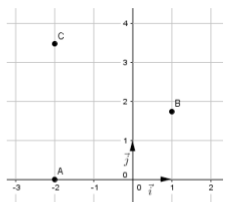I. Propriété
Soit un repère orthonormé (O,i,j).
Si u(x;y) et v(x′;y′) sont deux vecteurs, alors leur produit scalaire est donné par :
u⋅v=xx′+yy′.
Démonstration
Dans un repère orthonormé, on a :
∣∣u∣∣2=x2+y2 et ∣∣v∣∣2=x′2+y′2.
Leur somme est : u+v=(x+x′;y+y′).
Donc : ∣∣u+v∣∣2=(x+x′)2+(y+y′)2.
D'après la formule du produit scalaire :
u⋅v=2∣∣u+v∣∣2−∣∣u∣∣2−∣∣v∣∣2.
En remplaçant les normes :
u⋅v=2(x+x′)2+(y+y′)2−x2−y2−x′2−y′2.
En développant :
u⋅v=2x2+2xx′+x′2+y2+2yy′+y′2−x2−y2−x′2−y′2.
En simplifiant :
u⋅v=xx′+yy′.
II. Orthogonalité de deux vecteurs
Définition
Deux vecteurs u et v sont orthogonaux lorsque : u⋅v=0.
Remarque
Le vecteur nul 0 est orthogonal à tous les vecteurs de l’espace, car pour tout vecteur u :
u⋅0=0⋅u=0.
Propriété : Perpendicularité de deux droites
Deux droites sont perpendiculaires si et seulement si un vecteur directeur de l’une est orthogonal à un vecteur directeur de l’autre.
III. Un exemple
Dans le plan muni d’un repère orthonormé (O;i;j), on considère les points :
A(−2;0), B(1;3), C(−2;23).
1. Calculer ∣∣AB∣∣, ∣∣AC∣∣ et cos(AB,AC).
2. En déduire la mesure principale de l’angle (AB,AC) puis la nature du triangle ABC.
Solution
1. On a les vecteurs :
AB(3;3) et AC(0;23).
Donc : ∣∣AB∣∣=9+3=12=23.
Et : ∣∣AC∣∣=0+12=23.
Le produit scalaire : AB⋅AC=3×0+23×3=6.
Or, d'après la définition du produit scalaire :
AB⋅AC=∣∣AB∣∣×∣∣AC∣∣×cos(AB,AC).
=23×23×cos(AB,AC).
Ainsi : 12cos(AB,AC)=6.
Donc : cos(AB,AC)=126=21.
2. On sait que : \cos(\overrightarrow{AB}, \overrightarrow{AC}) = \dfrac{1}{2} > 0.
Cela signifie que : (AB,AC)∈[−2π;2π].
Ainsi : (AB,AC)=−3π ou (AB,AC)=3π.

En plaçant les points dans un repère, on en déduit que : (AB,AC)=3π.
Le triangle ABC est donc isocèle en A et (AB,AC)=3π.
On en déduit donc qu'il est équilatéral.

